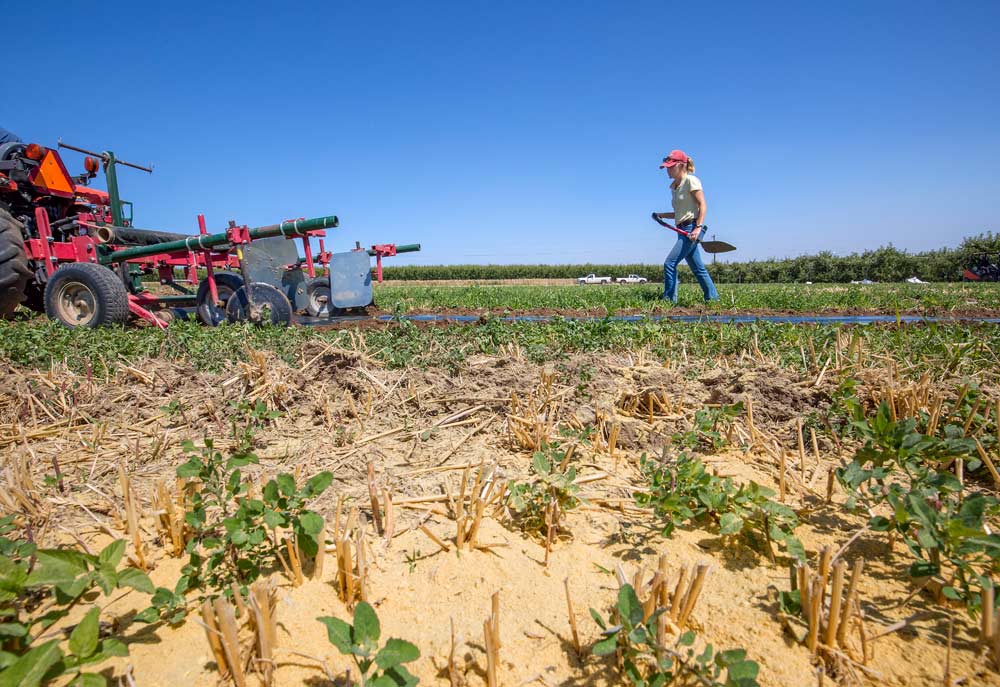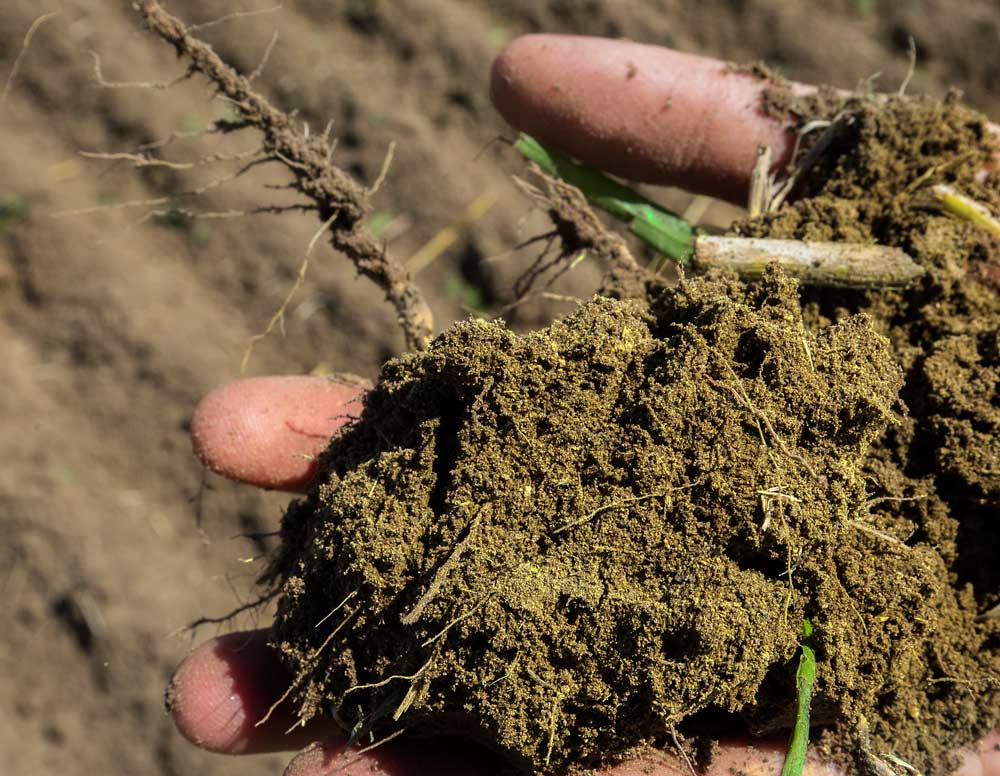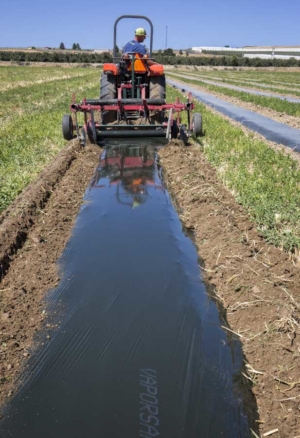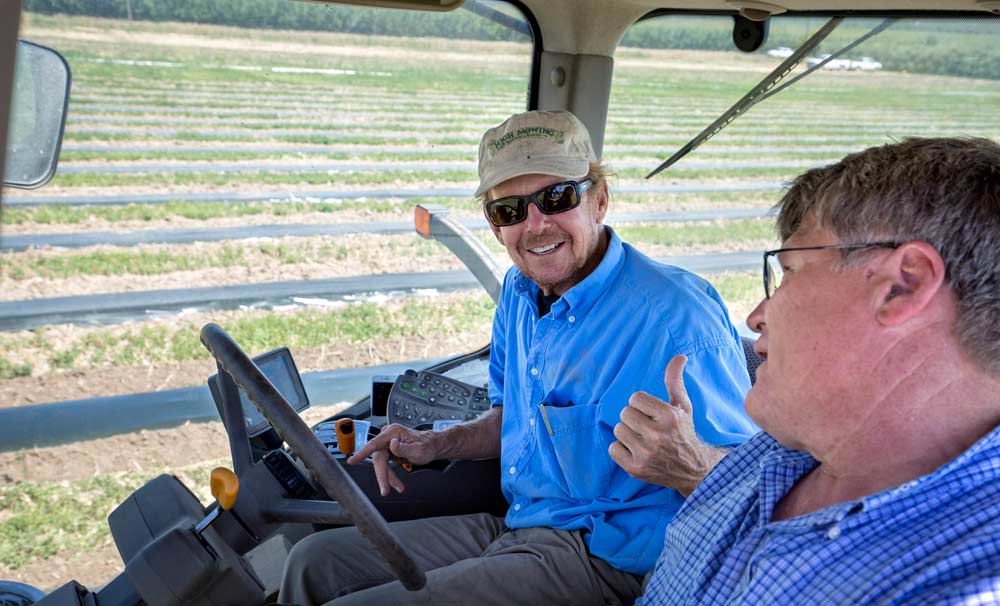
Mustard seed meal is spread, tilled and covered during a Washington State University extension experiment by Tianna DuPoint and growers Jim Baird and Mike Robinson to see if the treatment can offer an organic alternative to fumigation to control replant disease. The site, near Othello, Washington, will be planted with Cosmic Crisp this spring. (TJ Mullinax/Good Fruit Grower)
Every breath feels like a deep clean in your nose — like the sharp sting of horseradish or wasabi — as the tractor turns mustard seed meal into the soil. But will it create a clean slate for a new orchard as it does for your sinuses?
That’s the question being tested at a field trial in Washington’s Columbia Basin over the next few years, as grower Jim Baird plants Cosmic Crisp this spring on a replant site treated with mustard seed meal last year as an alternative to fumigation.
Experiments by U.S. Department of Agriculture pathologist Mark Mazzola showed that using mustard seed meal as a site preparation fights replant disease better than fumigation. It reduces parasitic nematodes and other pathogens as fumigation does, but because it also encourages certain beneficial microbes, the changes last longer. In five-year trials, production from trees in the mustard treated soils have produced as much or often more than the trees in conventionally fumigated soils.

Yellow mustard seed meal stands out in a handful of soil. Growers Jim Baird and Mike Robinson, who applied the soil amendment to a replant site in the Columbia Basin last summer, hopes that it will alter the soil microbe community to fight replant disease that lasts longer than fumigation. (TJ Mullinax/Good Fruit Grower)
At 12 acres, the Columbia Basin orchard will be the first field-scale test to measure the practicality and cost of the replant-disease fighting technique, said Tianna DuPont, Washington State University Extension specialist who is working with Baird and horticulturist Mike Robinson.
“The idea is that you’ve changed the community so that the benefits are equal to fumigation but go on longer,” Robinson said. “We hope to get an increase in quality or quantity of fruit, but we just don’t know yet.”
In the humid heat of summer, they spread the pungent yellow mustard seed meal in swaths across each tree row and tilled it in with a tractor. Then, they covered each row with black tarps to trap in the volatile mustard gases so they can do their work on the soil microbes.
“The goal is to increase the good guys to out-compete the replant complex stuff,” Robinson said. “But I’ll tell you what, you really don’t want to get it in your eyes.”
Less spicy is another fumigation alternative being tested at the site. Known as anaerobic soil disinfestation (ASD), the process uses plant biomass — in this case, triticale grown in the orchard last summer — tilled into the soil, soaked with water and covered with plastic tarps for several weeks. This creates an anaerobic environment in which certain bacteria that don’t need oxygen thrive and produce volatile compounds that are toxic to soil pathogens and nematodes as they break down the grass.
ASD is growing in popularity in California strawberry fields, where the organic technique often results in yields comparable to fumigation. But its performance depends on the pathogens present, the temperature and the type of grass or other plant material used, Mazzola said.

Tarping over the mustard seed meal aims to trap in the volatile compounds so it can create changes in the soil microbe community – killing pathogens and encouraging beneficials – to benefit trees in the long run. This trial, led by Washington State University extension educator Tianna DuPoint, is the first large-scale test of the technique that showed great promise in initial trials. (TJ Mullinax/Good Fruit Grower)
“These systems are complex,” he said. His own lab and field trials show that ASD can control apple replant disease, but lots of factors remain poorly understood for when and how it works. “We’re trying to pick apart this system so we can actually utilize it.”
One challenge of harnessing this complex biological process is that it needs to be done in the summer to get the ideal soil temperatures, DuPont said. Another downside is that “you need to give up a year of open ground,” Robinson said.
But, that year of lost production could be worth it if the anaerobic disinfestation proves itself. “It just takes more time, but you can just water in your existing alfalfa,” Robinson said, making it cheaper than buying tons of mustard seed meal.
The cost of mustard seed meal should hopefully be coming down soon, DuPont said. Farm Fuel Inc., the California-based company developing the mustard seed products, just began production in Sunnyside, Washington, working with a facility there to crush seeds grown in the Northwest, said CEO Stefanie Bourcier. That will lower access costs compared to trucking the product from California. The company plans to submit the pesticide registration for the crushed seed meal to the EPA this year, she said, so they can produce and market it for this use.
Moreover, Mazzola said some recent experiments suggest that lowering the rate of mustard meal by about a third provides the same tree growth and disease suppression benefits at lower cost.
To see if and how the alternative techniques work, the researchers are growing seedlings in the lab in the various soil samples and looking for the presence of fungal pathogens and nematodes in seedlings’ roots. Mazzola will also do a soil microbiome analysis to look for key indicator species and genetic sequencing to see how the entire soil community differs between treatments. Over the coming years, they will measure tree growth and production as well.
This year, DuPont plans to expand the study to two more sites, in Tonasket and Rock Island.
“We’re still kind of working out the kinks of how to implement and what our targets should be — How wet do we get the soil? What are the best carbon sources for ASD? — so we are continuing to narrow that down,” she said. “We’re taking what we learned last year and keep refining it and making sure it works in different types of soil.”

Growers Jim Baird, left, and Mike Robinson chat in the tractor on a break from tilling the mustard seed meal into tree rows at the site of a 17-acre experiment with fumigation alternatives in the Columbia Basin. Baird plans to plant Cosmic Crisp on the site this spring. (TJ Mullinax/Good Fruit Grower)
It’s great to see these new field trials that will help growers understand the costs and benefits of these treatments, Mazzola said, but he thinks more lab experiments are also needed, especially with ASD, to figure out how best to use the technique.
“If you don’t know why something is working and how the environment could alter the response, you could just be throwing money away,” he said.
Ultimately, he expects that companies will commercialize the techniques and offer them to growers as a service, similar to the fumigation model, he said.
Farm Fuel currently works with California growers to provide ASD as a service, from carbon sources to soil monitoring, Bourcier said, and it’s something they are open to with mustard seed meal in the future, perhaps in partnership with local ag service providers.
“It’s the application part that makes it an actual valuable tool for growers,” she said. •
—by Kate Prengaman






Leave A Comment